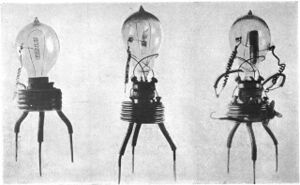Fleming valve (nonfiction)
The Fleming valve, also called the Fleming oscillation valve, was a thermionic valve or vacuum tube invented in 1904 by Englishman John Ambrose Fleming as a detector for early radio receivers used in electromagnetic wireless telegraphy. It was the first practical vacuum tube and the first thermionic diode, a vacuum tube whose purpose is to conduct current in one direction and block current flowing in the opposite direction.
The thermionic diode was later widely used as a rectifier — a device which converts alternating current (AC) into direct current (DC) — in the power supplies of a wide range of electronic devices, until beginning to be replaced by the selenium rectifier in the early 1930s and almost completely replaced by the semiconductor diode in the 1960s. The Fleming valve was the forerunner of all vacuum tubes, which dominated electronics for 50 years.
The IEEE has described the Fleming valve as "one of the most important developments in the history of electronics", and it is on the List of IEEE Milestones for electrical engineering.
In the News
Fiction cross-reference
Nonfiction cross-reference
External links:
- Fleming valve @ Wikipedia
Attribution:
